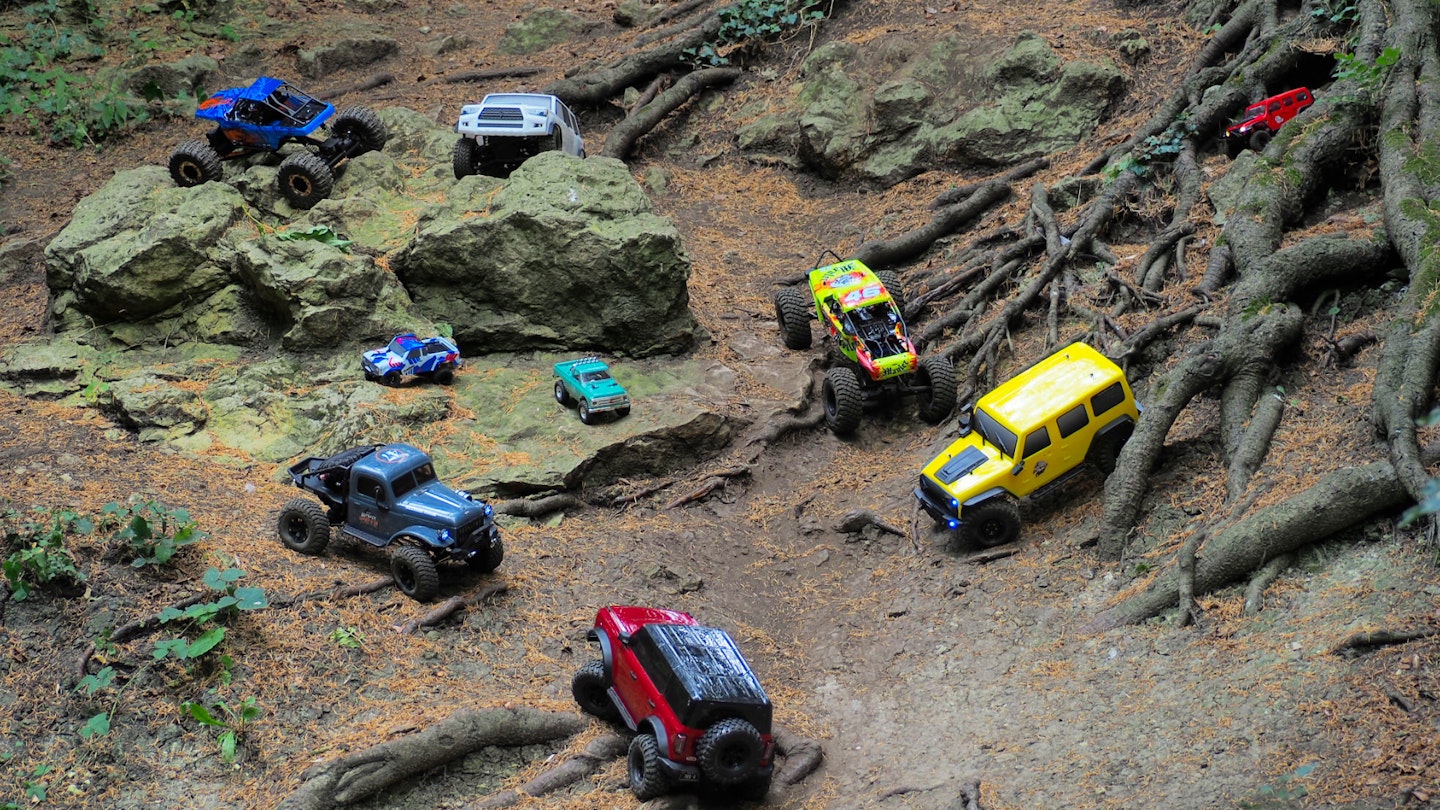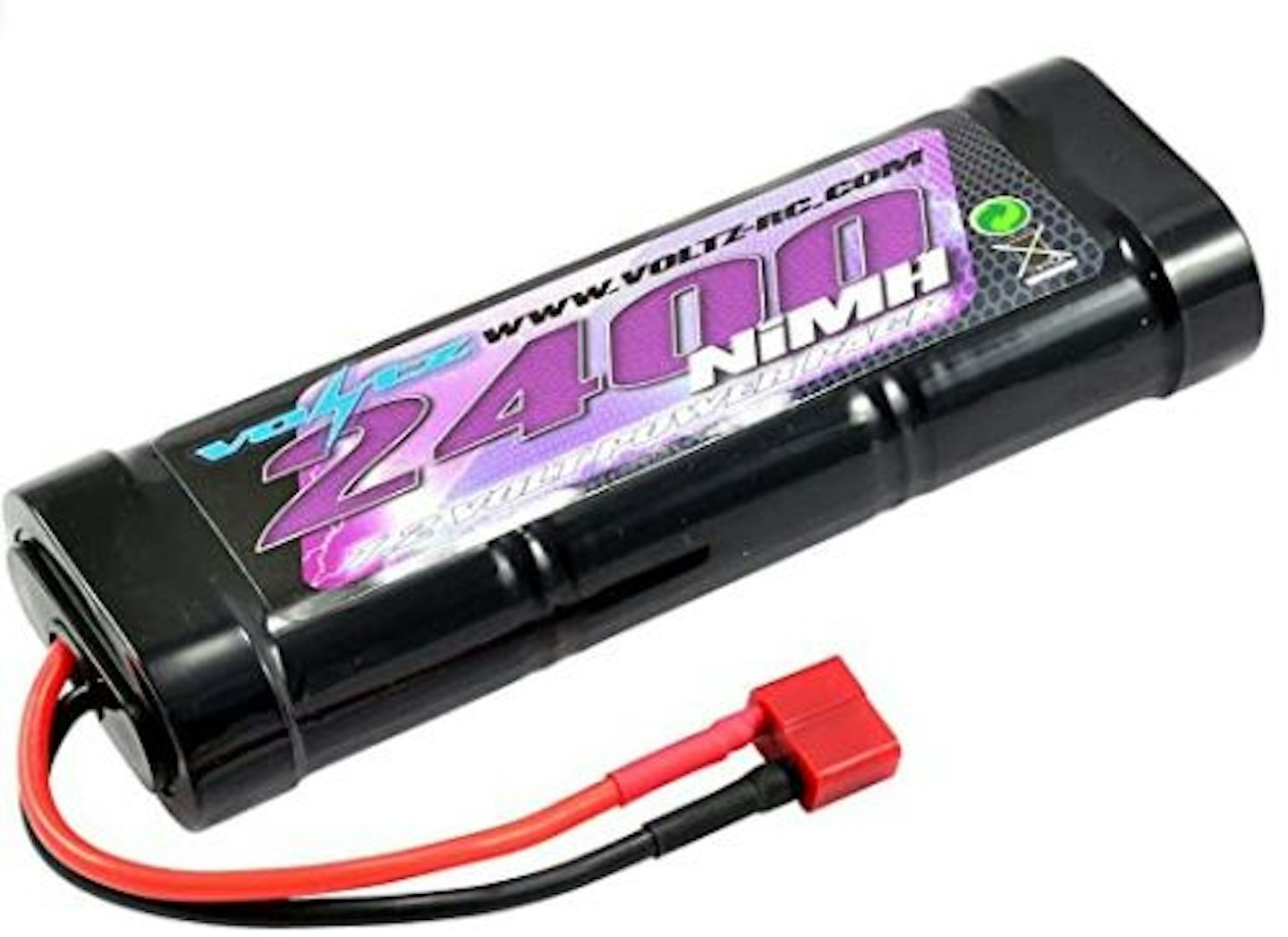Nibbles are fantastic. They don't demand the investment that a full-size meal does and you get to experience many different flavours in one sitting. Perhaps the same is true of cars? If you shrink your garage, you get to enjoy a wide range of vehicles without being moneybags.
We're testing this hypothesis.
It’s impossible not to be immediately intrigued by the notion of miniature hardcore off-roaders. Naturally, they are cheaper than their full-size relatives, but it’s more than that; it’s the accessibility. If you own a Land Rover, Landcruiser or some similar land-based mud plugger, taking them out for a worthwhile trek is quite a mission. Making sure the machine works, negotiating time off from work and/or family, lobbying environmental groups – it's all rather a faff.
By contrast, CAR managed to gather together no less than eight allegedly highly capable off-road machines and walk them to the proving ground located in Winnie-the-Pooh’s forest just behind our office.
Jump to:
What are RC rock crawlers?
If you can't stand the sight of your racing games anymore and wish to continue indulging in your passion for cars and driving outside in the real world, RC rock crawlers are a potential avenue.
Put simply, they are the toughest type of remote-control vehicle you can get, designed specifically for attacking tough terrain, be it wet or dry.
There are two types you will come across, one being the dune buggy, Ultra4-style crawlers, the others being based on actual vehicles like Land Rovers and Ford pickups. The idea behind either body type is the same: to be able to take a beating and keep going. They are all about substance over style. You wouldn’t take your car off-roading or mud plugging, but if you’re interested in that sort of thing, an RC rock crawler gives you access to this fun world.
Quality RC rock crawlers are not cheap relative to other remote-control cars. But the top-tier RC rock crawlers undergo development testing as vigorous as that of any full-size off-road vehicle. And the motivation behind this test is to see if they're worth the time.
CAR's rock crawler line-up:
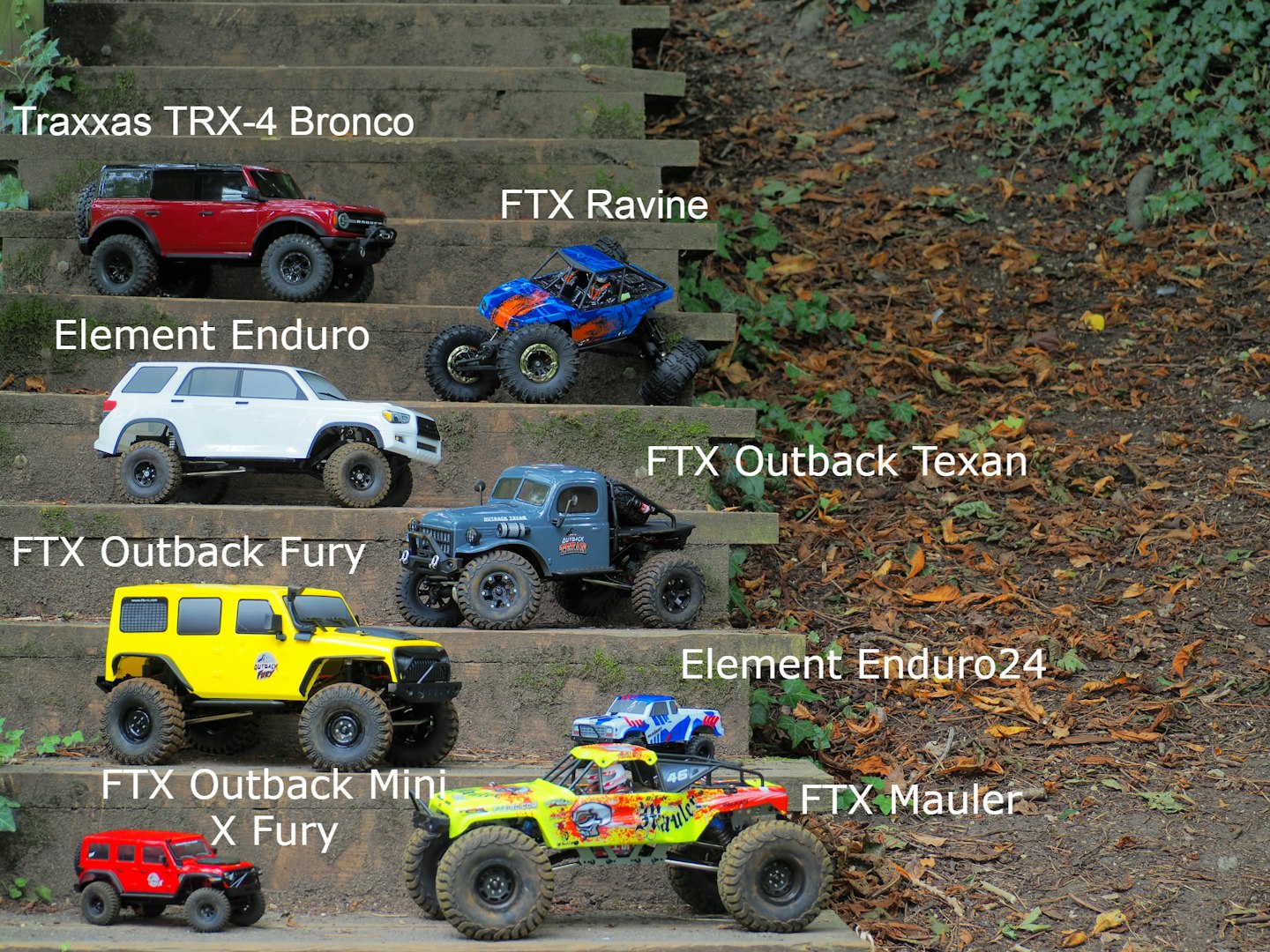
Traxxas TRX-4 Ford Bronco (1:10)
Price: £686.99
Briefing: First electric Bronco; loads of features but by far the most expensive – the true Apple of this test.
FTX Ravine (1:10)
Price: £114.99
Briefing: Comes with crab, combine harvester, regular, and Porsche 918 steering modes; also possesses mad articulation.
Element Enduro (1:10)
Price: £369.99
Briefing: It’s priced between the Bronco and Fury – juicy; based on the Toyota Forerunner and therefore looks amazing; surprisingly small wheels.
FTX Outback Texan (1:10)
Price: £319.99
Briefing: Love those Mad Max looks; underneath it bears upgrades from the Fury.
FTX Outback Fury (1:10)
Price: £219.99
Briefing: It looks to be bang for buck or compromised; Adam Binnie says it’s quick; looks like a Transformers vehicle.
Element Enduro24 Sandero (1:24)
Price: £99.99
Briefing: Small in size but hopefully big in heart; this is the world’s most adorable 4X4.
FTX Mauler (1:10)
Price: £179.99
Briefing: Looks to be a bit of a mountain goat; yet, it’s strangely good value; what’s going on here?
FTX Outback Mini X Fury (1:18)
Price: £99.99
Briefing: Being slightly bigger than the Enduro24 could result in significant ability advantages; it’s also red so it must be fast.
Where to begin?
Indeed. This is virgin territory for many; the RC rock crawler enthusiast elite will be exciting themselves like a bandit horde in anticipation of the CAR team foolishly blundering, inexperienced into their territory. I must address the bandits and let them know that we possess one Alan Taylor-Jones - a battle-hardened veteran that knows this territory well. Plus, we do know a thing or two about cars ourselves, which does pay dividends.
However, for the most part, we are focused more on the fun side of RC rock crawlers. We are interested in what drives these machines (of course we are), but we are also desperate to share with you what each is like to drive and how each performs in this gladiatorial test. Besides, we delve into more detail about each model in their forthcoming individual reviews.
It must also be pointed out that there are two tiers of machine here. We cannot and will not compare the little’uns to the big’uns because that is like comparing a cupcake to a wedding cake; a single bed to a king-size bed; a tabby to a tiger. It just isn’t fair. So while this is CAR’s big RC rock crawler test, it is also split into the 1:10’s and the other two.
The hillclimb speed test
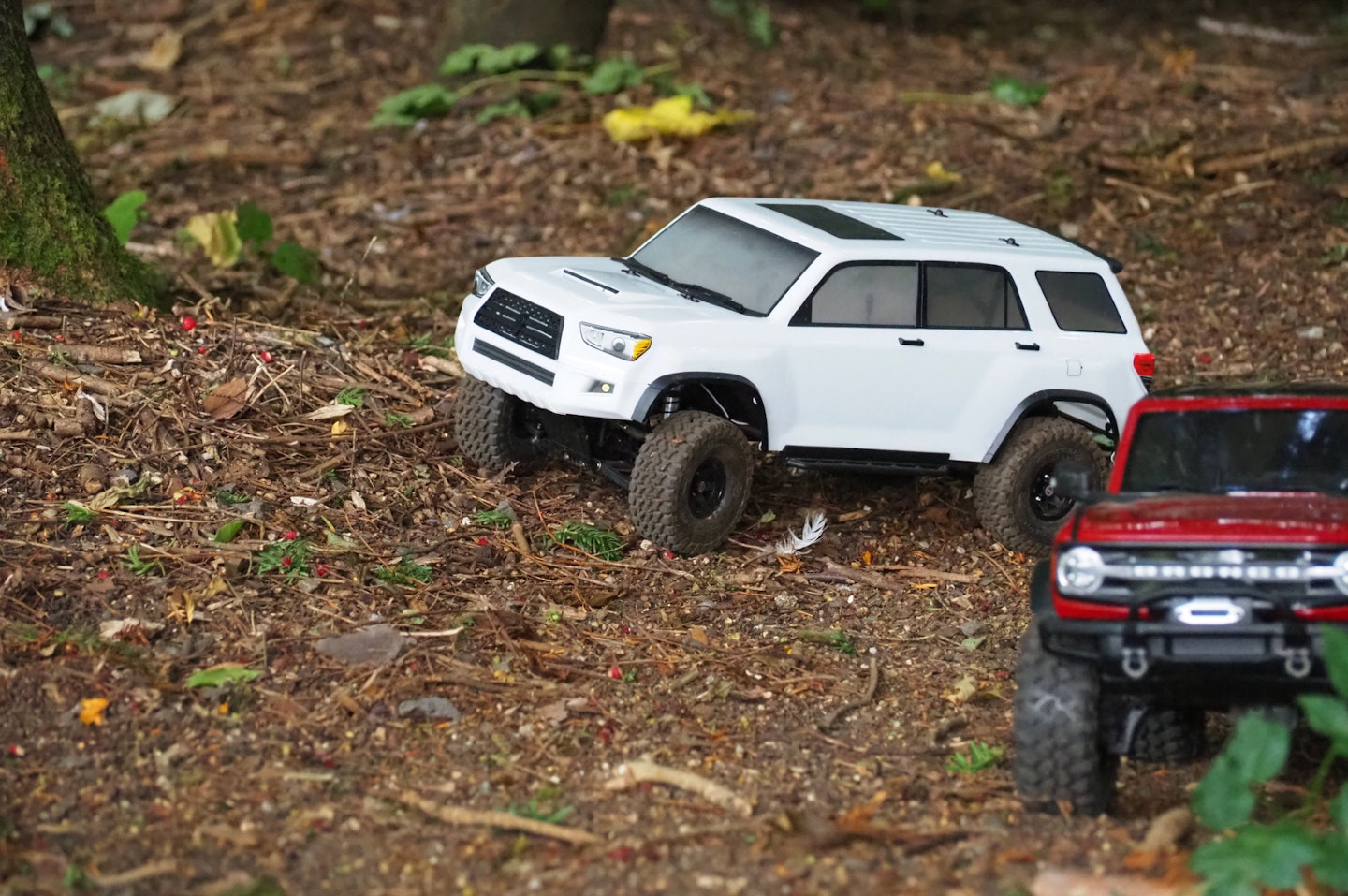
The category name ‘rock crawler’ is a clear indication such machines are not about speed. But Ryan Gilmore, Adam Binnie, and I immediately came to an agreed decision that we didn’t care and wanted to find out which was fastest anyway. Because you do too.
Somewhere amongst the trees, we established a fast and relatively easy hill-climb route that cut directly up a slope between parallel walking tracks. The only obstacles were two small sections of tree roots.
If there is some unwritten rule governing speed on rock crawlers, Traxxas either did not receive it or decided not to honour it. It went first, and with Ryan at the wheel/trigger and high gear engaged, it simply TARDISed its way from the start line to the finish line, completing the 30-odd metre course in 10.98 seconds. I’ll say it now, nothing else even got close to that.
The hill-climb revealed that neither the Mauler nor the Ravine cared much for loose surfaces. They churned up the incline in a steady but leisurely mass of wheelspin. But sending them careering back down the hill showed how much more stable they were than the trucks. The Mauler’s motor also sounded odd. It reminded me of something and it took me a while to realise what that something was: the slightly reedy whine of the Mauler mimicked the elongated mating sounds of a tortoise. I only made this connection because my other half owns a tortoise.
Finger to the trigger action divulged important characteristics of the other vehicles, too. The mini Fury wasn't fast, even though it was red. The yellow Fury was indeed quick, completing the course in the best time of 13.66 seconds, but it was quite wayward and threatened to tumble like a running toddler.
Element's Enduro was the slowest of the bigger trucks, doing its best in an octogenarian 22.38. But it possessed a stoic, unfaltering drive we were keen to explore further. Meanwhile, the Texan, though faster, had a short steering spectrum. It was either full left or full right with little in between (like most people on social media these days) and therefore climbed the track weaving from edge to edge.
| Hillclimb times | |
|---|---|
| Traxxas Bronco | 10.98 seconds |
| FTX Outback Fury | 13.66 |
| FTX Mauler | 16.38 |
| FTX Outback Texan | 16.91 |
| FTX Ravine | 20.64 |
| Element Enduro | 22.38 |
| FTX Outback Mini X Fury | 53.10 |
| Element Enduro24 | 1 min 15 |
With the speed test completed, we moved on to the important stuff.
Rock bashing and slope scrambling
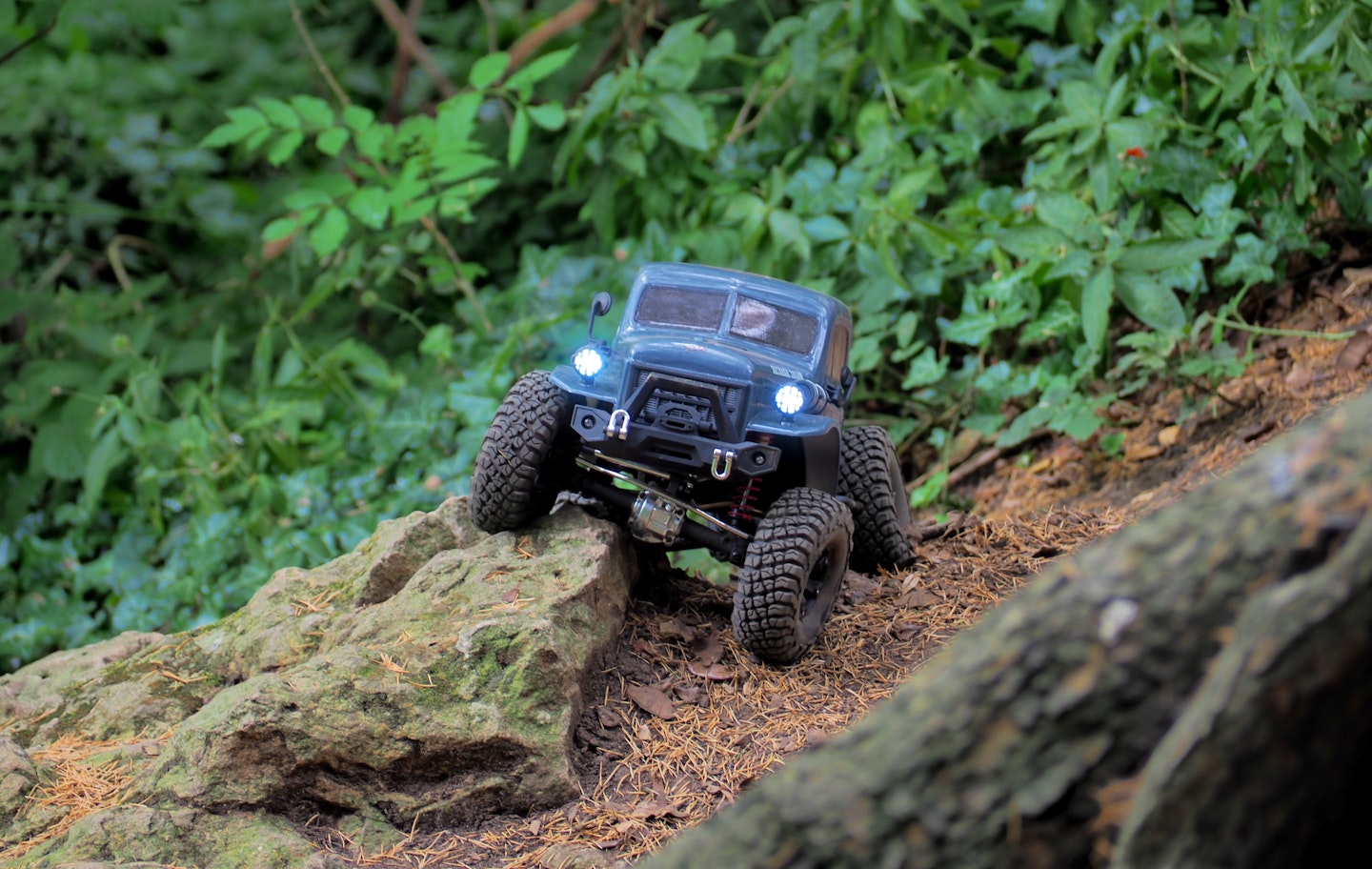
The terrain selected for this test was rather formidable. The hillside itself was steep enough to deny Ryan and his Converse sneakers any chance of reaching the top. Additionally, veiny tree roots spread all over the slope, forming a kind of valley up the centre between the protruding boulders.
Every component of the rock crawlers would be tested here. If a rock crawler was to tackle the incline, it would need torque and grip. If a rock crawler was to conquer the tree roots and rocky obtrusions, it would need ground clearance, generous suspension travel, good axle articulation, and tyres that could mould over obstacles. If a rock crawler was to avoid a tumble, it would need both lateral and longitudinal stability. And if a rock crawler did take a tumble, it would need to be tough enough to get straight back out there.
The first machine into the arena was the Element Enduro piloted by Adam, while I readied the Mauler and Ryan, with sights set on the Outback Fury, cursed at rummaging through the pile of controllers for the third time.
Before we dive headlong into the forthcoming battle, I did want to mention that all bodies except the Traxxas Bronco are held to the chassis by pins pierced through body posts. The issue was exaggerated for us dealing with eight machines, but the pins are an incredibly irritating means of accessing the underbody components. Mercifully, Traxxas has had the insight to use clips under each wheel arch that you simply pull to release and to replace the body the clips click into place themselves. The Texan and Mauler weren’t too bad. The former has one pin underneath the front bumper and is hinged at the back; the latter with two pins at the back and hinges at the front.
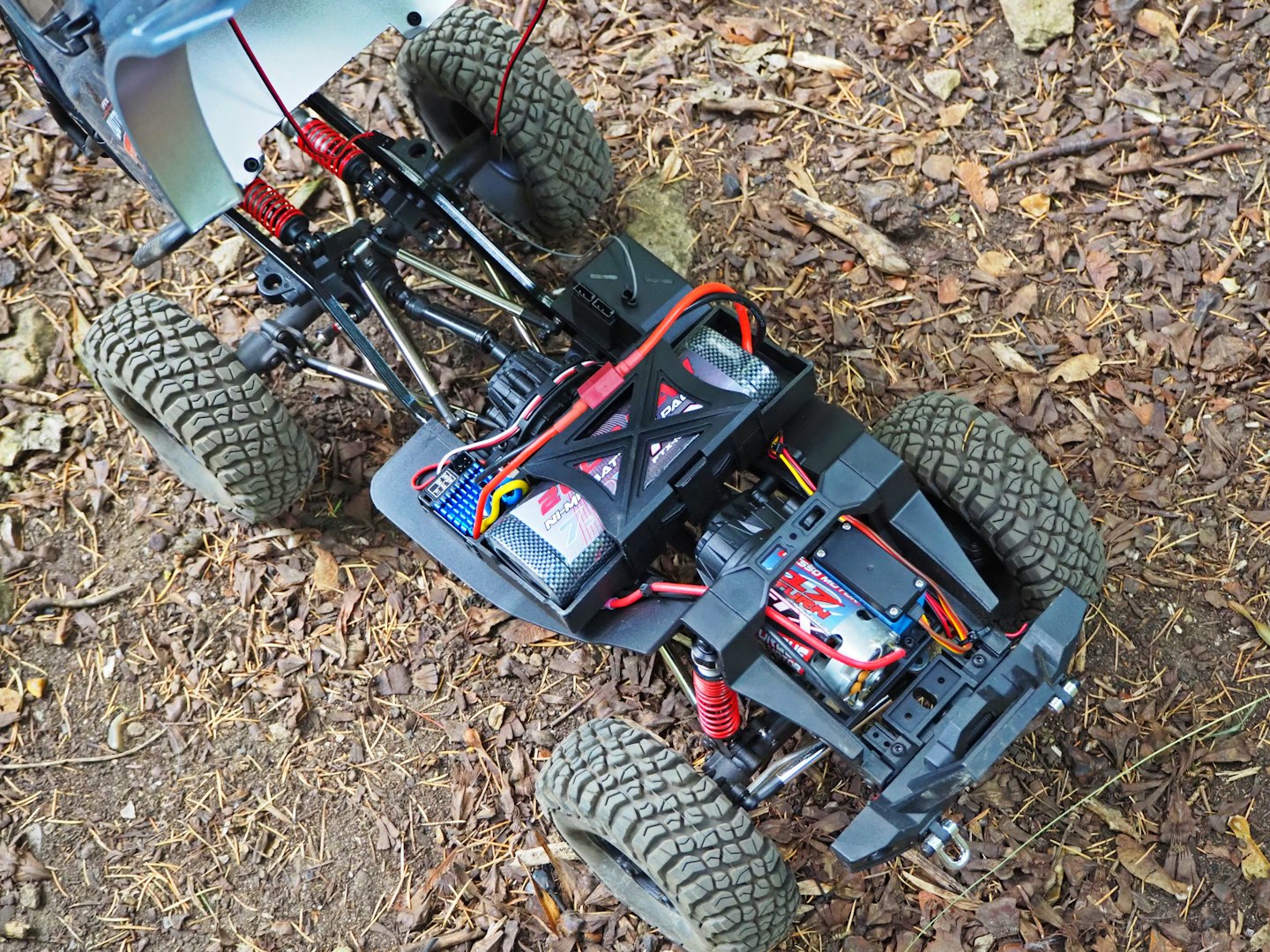
With the white Enduro leading the way, the rock crawlers advanced to clash on the slope we have christened ‘Crawler Hill’. It became immediately apparent the incline, particularly the valley, was even steeper than we initially thought. The Enduro tentatively began to climb and pointed its nose directly at the sky as if in prayer. It reached the rocky shelf that would prove to be the major obstacle for our machines. That section of the outcrop was slippery and positioned at such an angle that made a head-on climb impossible. A run-up would result in a certain tumble down the hill, so the only hope was to get one or two wheels over the lip and try to hop the truck over without rolling it.
The Enduro pored away but would not quite do it. Adam therefore changed tack, retreated the Enduro and swapped to tackle the valley in the Mauler. It was immediately clear that the Mauler was more at home in this terrain with is huge tyres and lower centre of gravity.
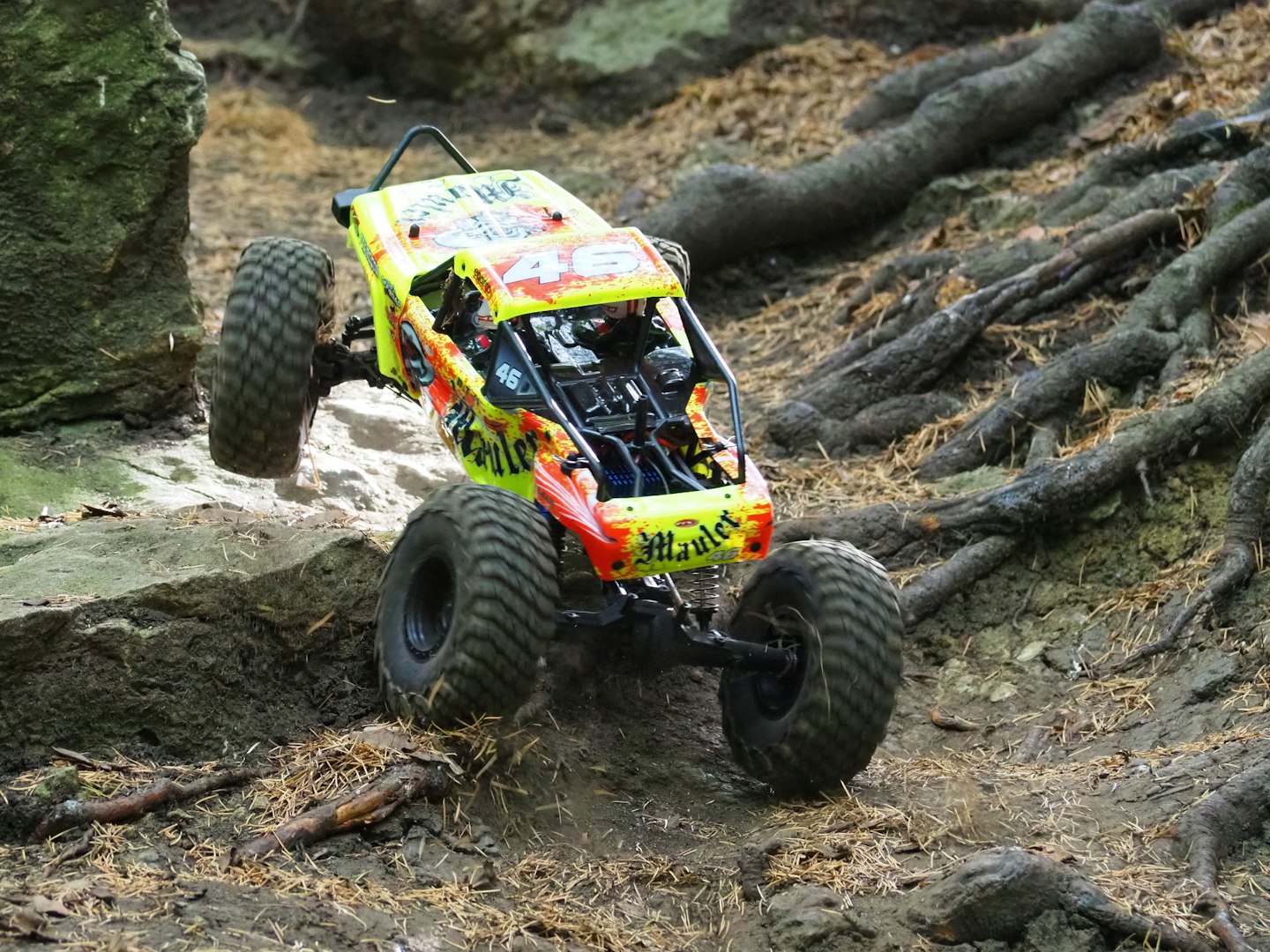
The yellow and red Mauler charged at the rockface, as seemed appropriate; the Mauler’s front wheels bounced over the lip but its rear wheels caught, and what would’ve made all the difference there is some extra power. The Mauler could really do with some extra oomph. We persisted, sure that the Mauler would prevail until it bounced too high and the inevitable happened.
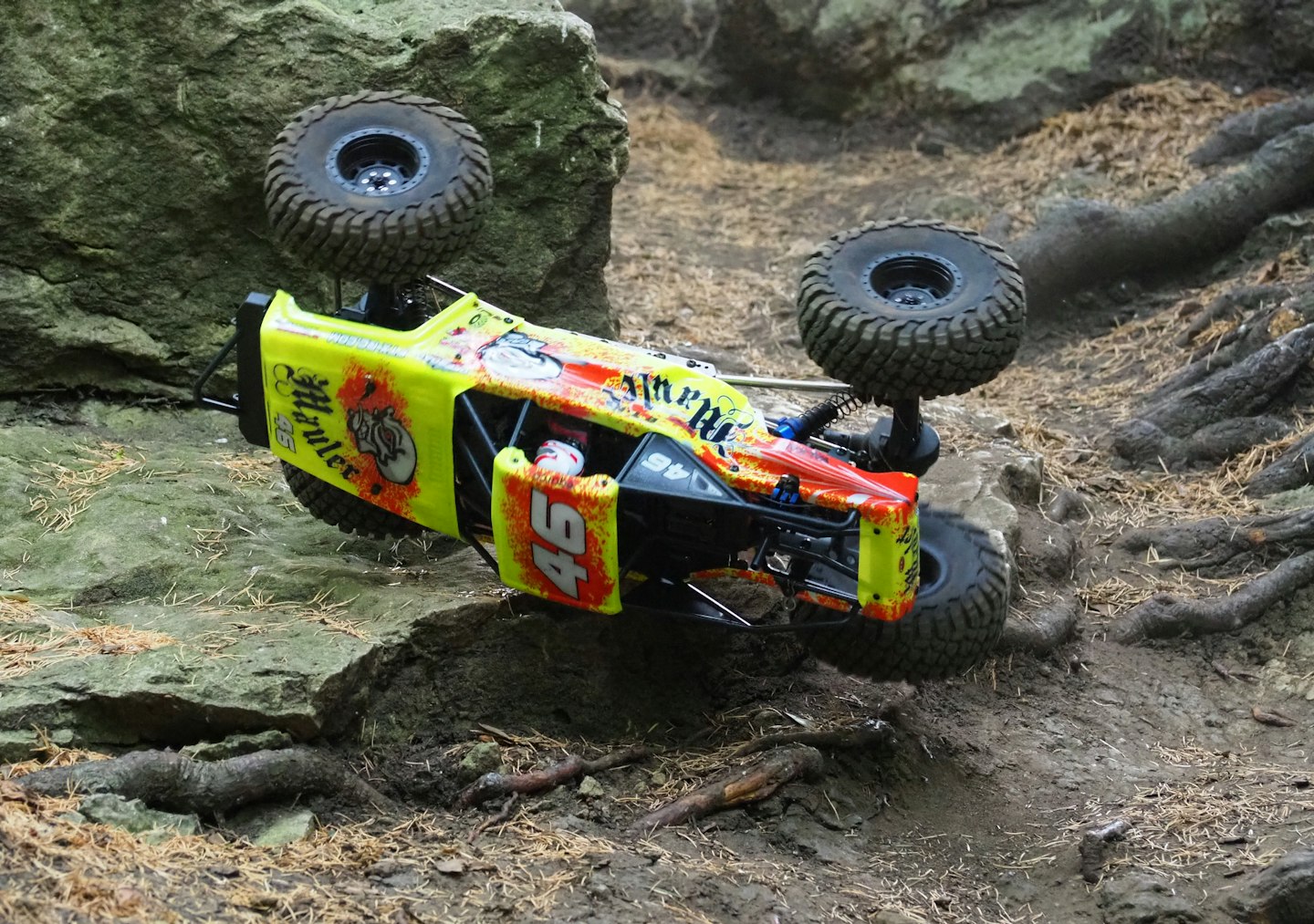
Ryan then had a go with the Outback Fury. As had been evident in the hill-climb, the Fury felt the least stable and therefore we were not expecting victory here. Indeed, the Fury rolled even before it had a chance to rock scramble.
Adam meanwhile, had skirted the Enduro round to left, attempting an alternative route around the front and then left left-hand side of the large boulder. Though not as steep as the valley, it demanded lateral stability, which the Enduro has, but the Fury does not. It was frustrating. The Fury had ample power and grip but it was just too unstable on the steep hill face. Careful though we were, time after time it rolled until it proved one roll too many and a rear suspension link bolt sheared. Fearful of inflicting more serious injury, we pulled the Fury from the fight. With Adam persisting with the defiant Enduro, I readied the Traxxas and Ryan fetched the Texan.
The Bronco, the Enduro, and the Texan
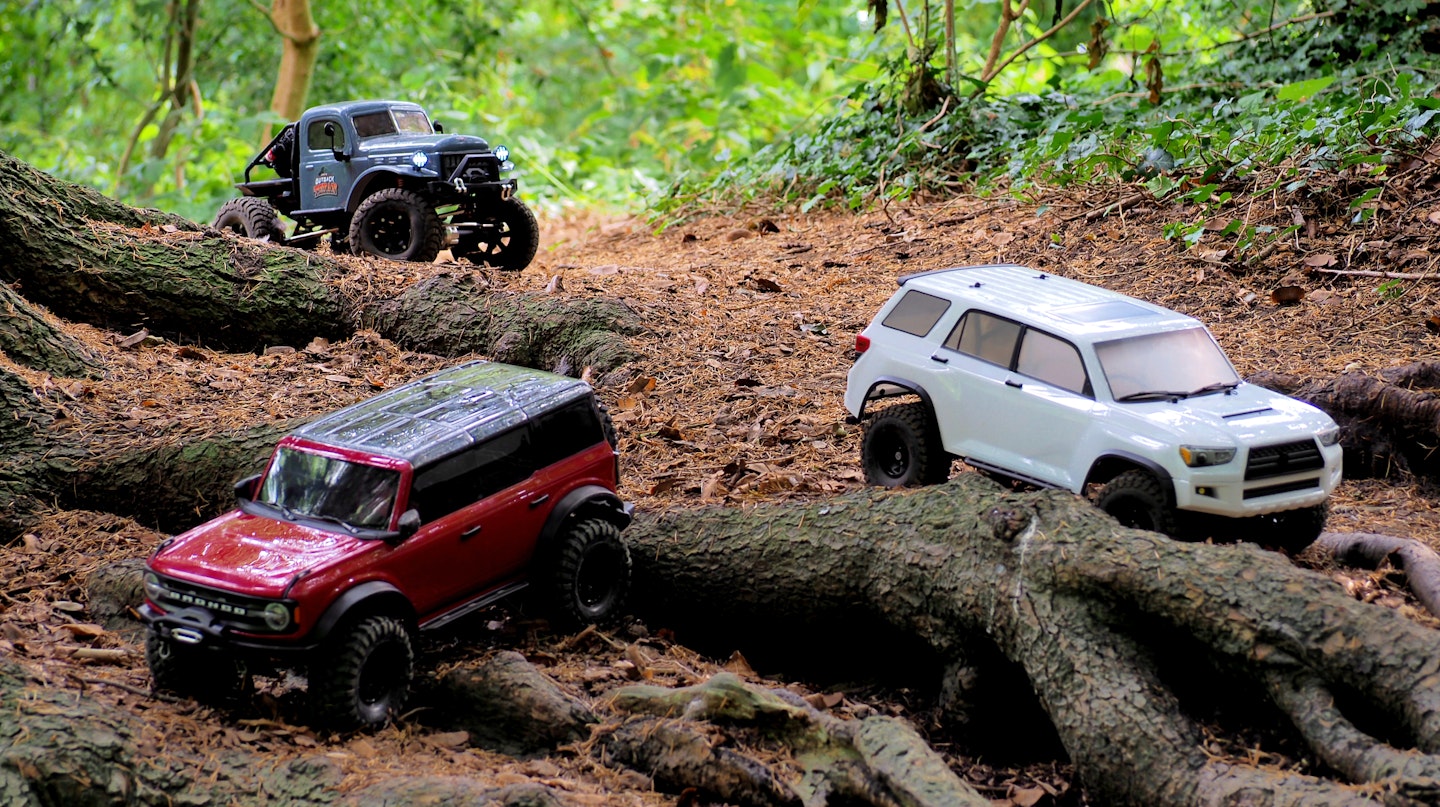
The Bronco and Texan followed the Enduro’s route in pursuit, and this became a very interesting contest.
Things began well for the Enduro. This new route demonstrated the Enduro’s superior lateral stability to the Bronco and Texan, with both rolling into the undergrowth where the Enduro had continued. But neither was going to be flummoxed so soon. Righted, the pair set off in pursuit once again.
Where both Bronco and Texan shine above the Enduro is in tyres. This was a surprise because the Enduro sports officially licensed General Grabber A/T X tyres. But they simply didn’t grip as well as the Canyon Trail tyres on the Bronco or those on the Texan.
We proved earlier that the Bronco is by far the fastest, but purely because it is the only one with high and low ranges. Flick the Bronco into low range for crawling and the playing field evens out. Almost. When rock crawling, neither the Texan nor the Element feels underpowered compared to the Bronco. Their motors power them up the same slopes just as relentlessly. And the Texan's haphazard steering was not such an issue at crawling speeds.
As one would hope, the Bronco does have more weapons to deploy. It’s the only machine in this lineup that has remote locking differentials and different drive modes. To much amusement, it also features cruise control. Though the Enduro had come out swinging, as we tackled more terrain and got our eye in for control, it became apparent the Bronco was indeed the top dog here. It’s the only one (with the possible exception for the Ravine) that we found we weren’t constantly commenting on what we would change.
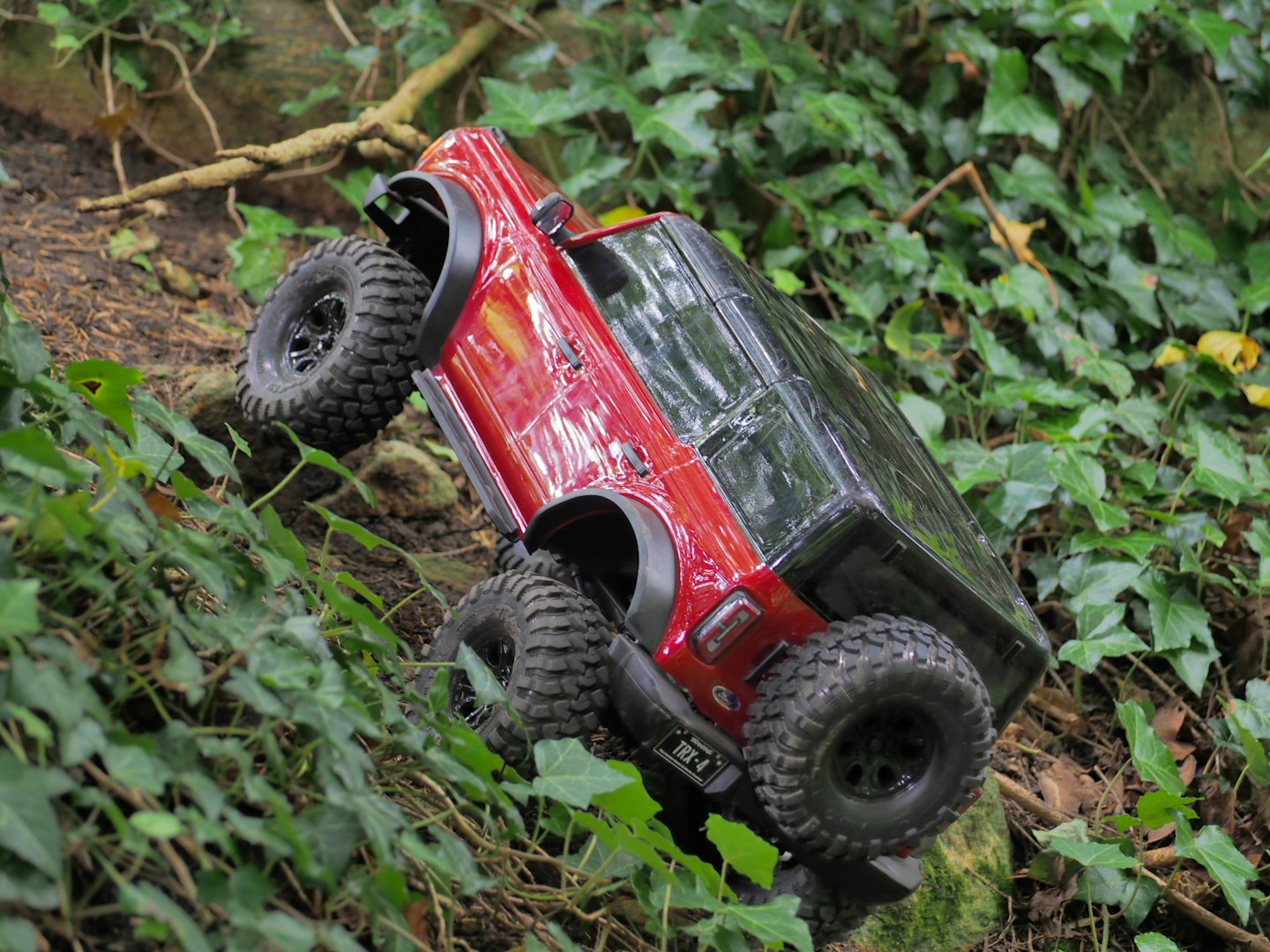
Modifying is a natural part of rock crawler ownership but it’s important to find out how they perform out the box because for people new to this, that’s where you begin and you want something that won’t simply fold like a cardboard box, spark like counterfeit electronics, or hoist a white flag at the first sign of a challenge. With the Enduro the main annoyance was the tyres; with the Texan, it was the slightly haphazard steering at higher speeds; more power would benefit the Mauler; the Fury needed fixing; the Bronco was almost totally sound as it was.
While the Enduro had better lateral stability, it became clear the Bronco had better longitudinal stability as Adam and I drove the respective vehicles down the valley. With the Bronco leading the way down, the Enduro simply lost its footing and fell head over heels, the Bronco suddenly acting as an involuntary safety net.

In terms of outright ability, the Bronco was the victor of the three. And the quality of its components is remarkable. But Ryan, Adam, and I agreed that the Enduro and the Texan were not far behind. And the price difference is immense. If you had the money, we were in consensus that the Bronco should be the go-to, and it is the machine I naturally kept going back to drive. But for those new to RC rock crawling, the Enduro and Texan offered only marginally inferior climbing ability for much, much less money. Think of the Bronco as a slow-cooked lamb shank: exquisite and as good as you’d been hoping. Think of the Texan and the Enduro as a restaurant lasagna: much better than you were expecting.
The Ravine and the Mauler
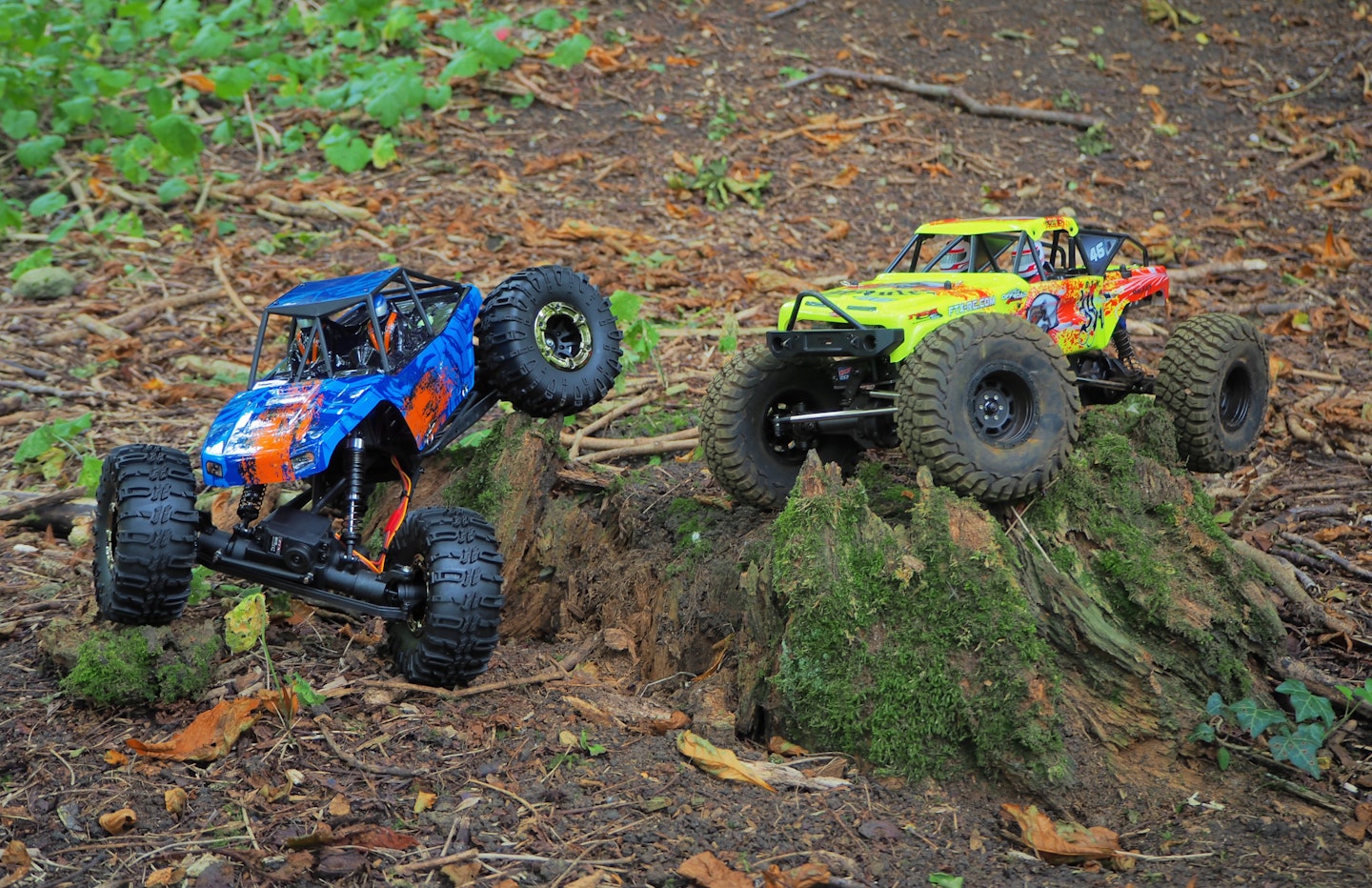
Tagging in the Ravine and Mauler brought into stark contrast the two opposing methods of scaling terrain. One is the tentative, tactical approach, as the SAS use; the other is the American shock and awe full-throttle approach of the Ravine and Mauler.
These two models are so much more stable than the others, and with their ‘wheels first’ shapes, can tackle any obstacle – their approach angle is ‘any’. To everyone’s amazement, the Ravine simply danced up the yet-to-be-conquered valley and on its second attempt, so too did the Mauler, thus proving our theory on an impossible run-up void. The key to their success is their ability to continually bounce around on an obstacle until they are able to find a grip. The others can’t be so aggressive, they’d simply roll over. While the Ravine and Mauler both struggled on the smoother, loose-surface hill-climb, their big 2.2-inch tyres came into their element on the tree roots and rocks.
The Mauler is probably the easiest machine to drive out of the lot. The steering, though not as delicate as the Bronco, is accurate enough and goes where you point it. And all you have to do is pull the trigger to full. With Bronco et al, you have to be more precise. The trade-off of the high-revving fast thrills of the Mauler (and Ravine) is that the battery drains quite quickly.
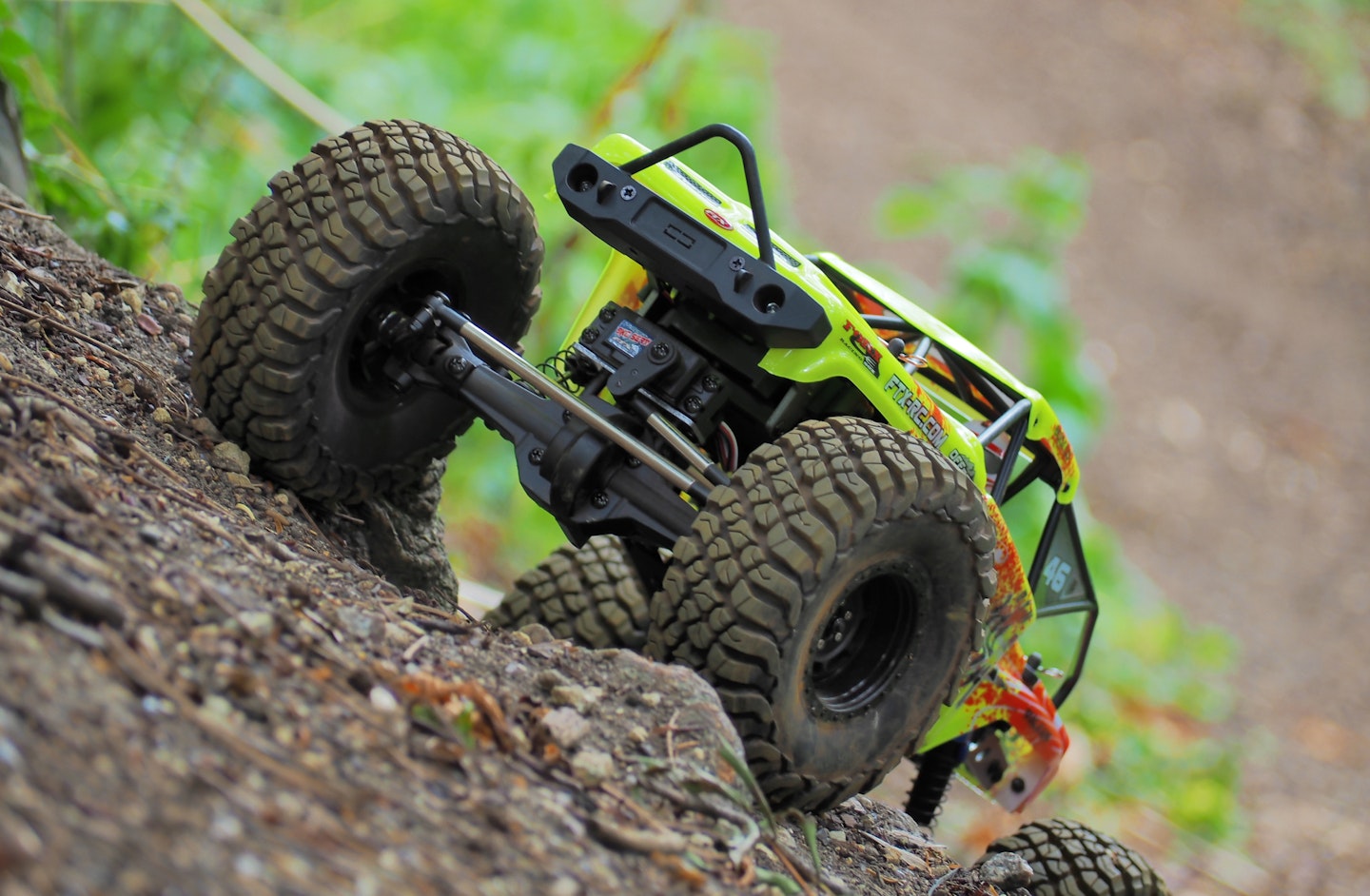
But like the trucks, the Mauler can be modified. Wheelbase, suspension, almost whatever you like. Perhaps giving the Mauler some bigger cajones and a larger capacity battery would be where we’d start.
The Ravine is arguably the most fun to drive. It’s the only one that will do doughnuts because while everything else has a single motor and four-wheel drive, the Ravine has two electric motors and four steering modes: front, front and rear opposite lock, front and rear crab-style, and rear. You can therefore make the Ravine normal, mountain goat-agile, Mr Krabs scuttle or combine harvester ridiculous.
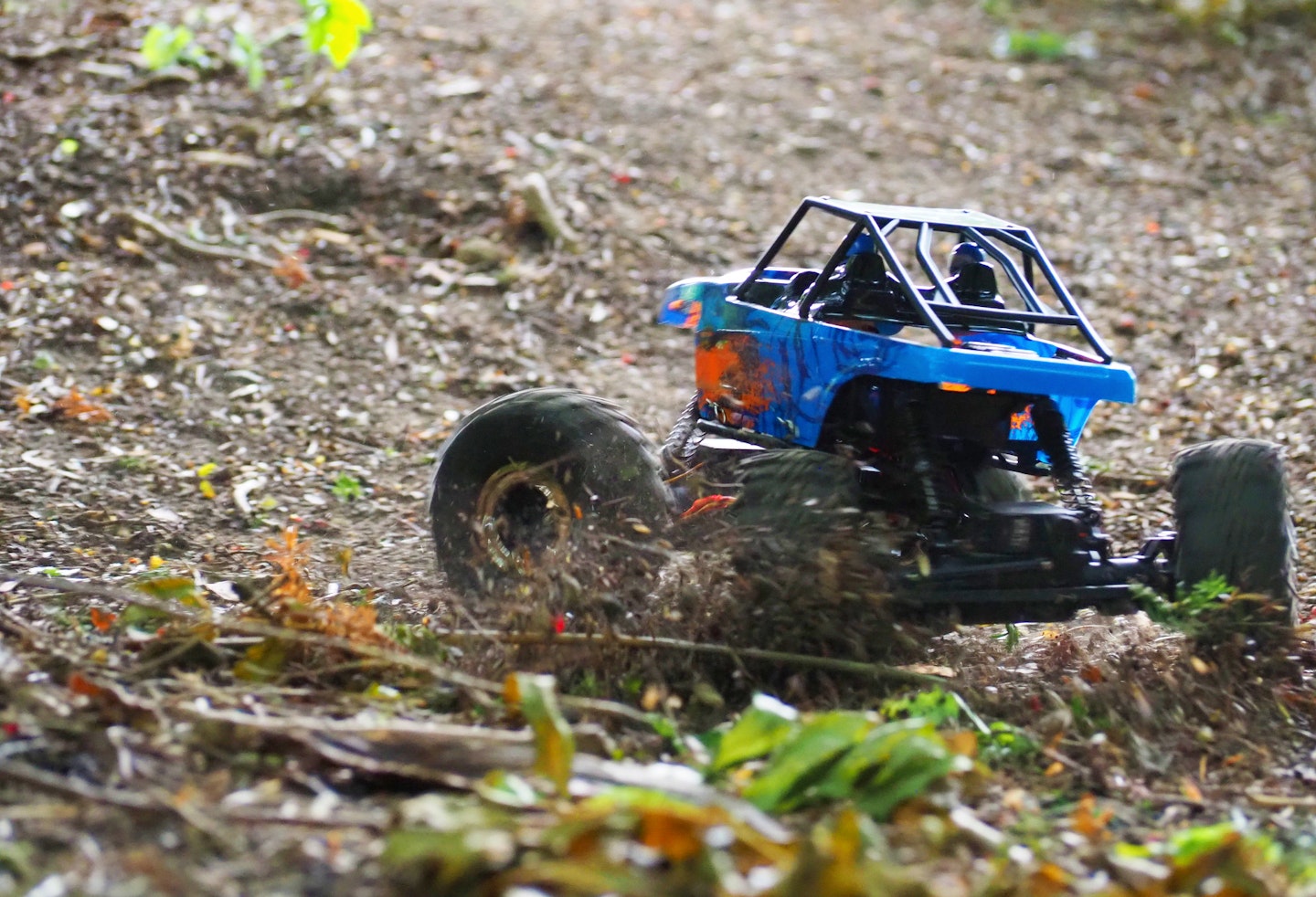
But be in no doubt that the Ravine is hugely capable. Its scaling ability is amazing, made more so considering it’s the cheapest 1:10-sized machine here by a huge margin. Diehard RC rock crawler enthusiasts will likely despise it for this reason. Though in fairness to them, it is clear that the Ravine cannot really be modified; what you get is what there is. You can replace parts but the enthusiasts will maintain on labelling the Ravine a toy.
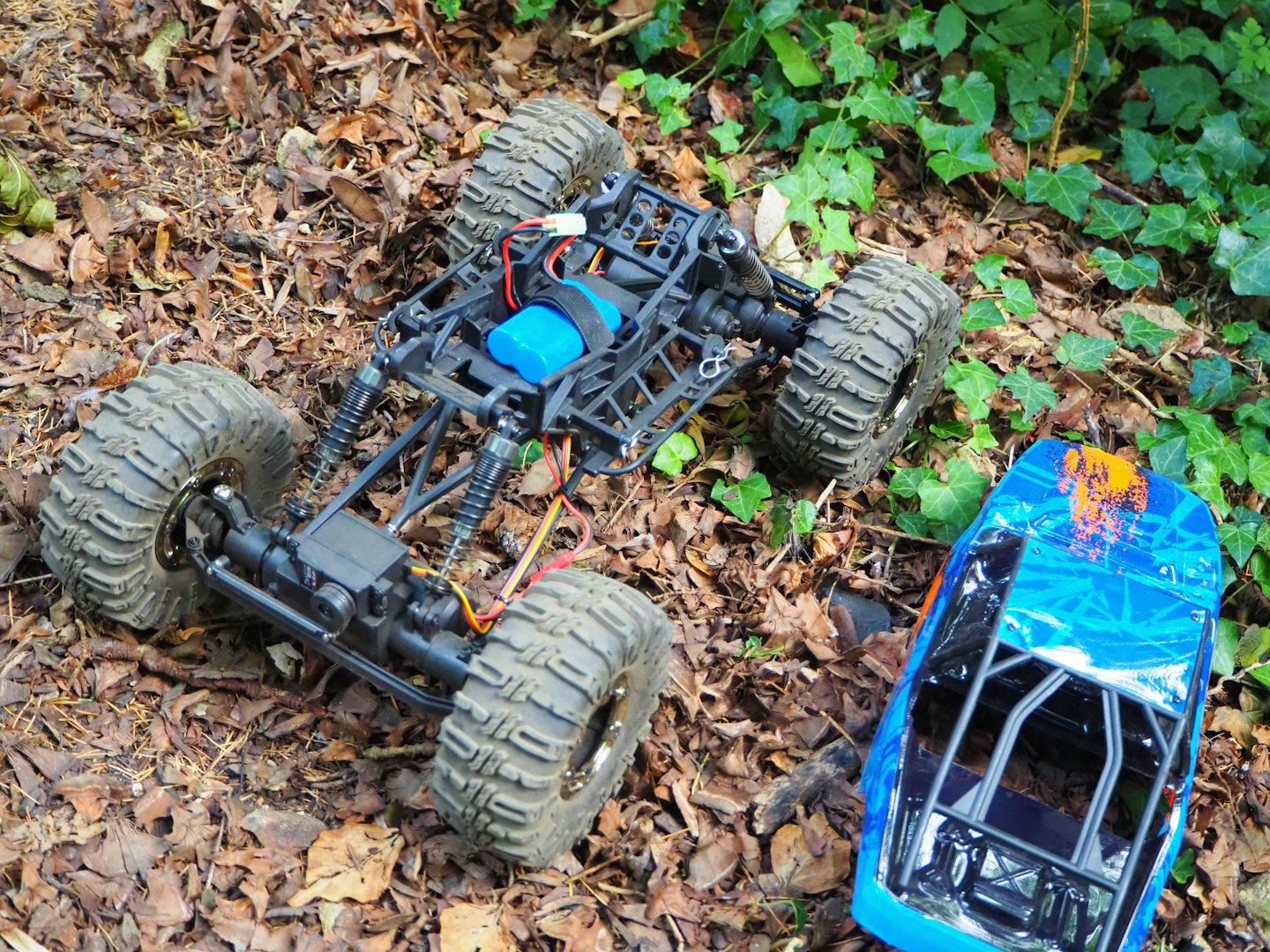
I wouldn’t be put off by their belittling though. If anything it serves to prove the Ravine as something of a giant killer that can make the invested establishment look silly. Perhaps the Ravine should therefore wear a Cosworth badge. We had an absolute blast driving the Ravine, and the Mauler too. If you desire an off-road RC car that is, primarily, about having fun, these are probably your best options.
The minis
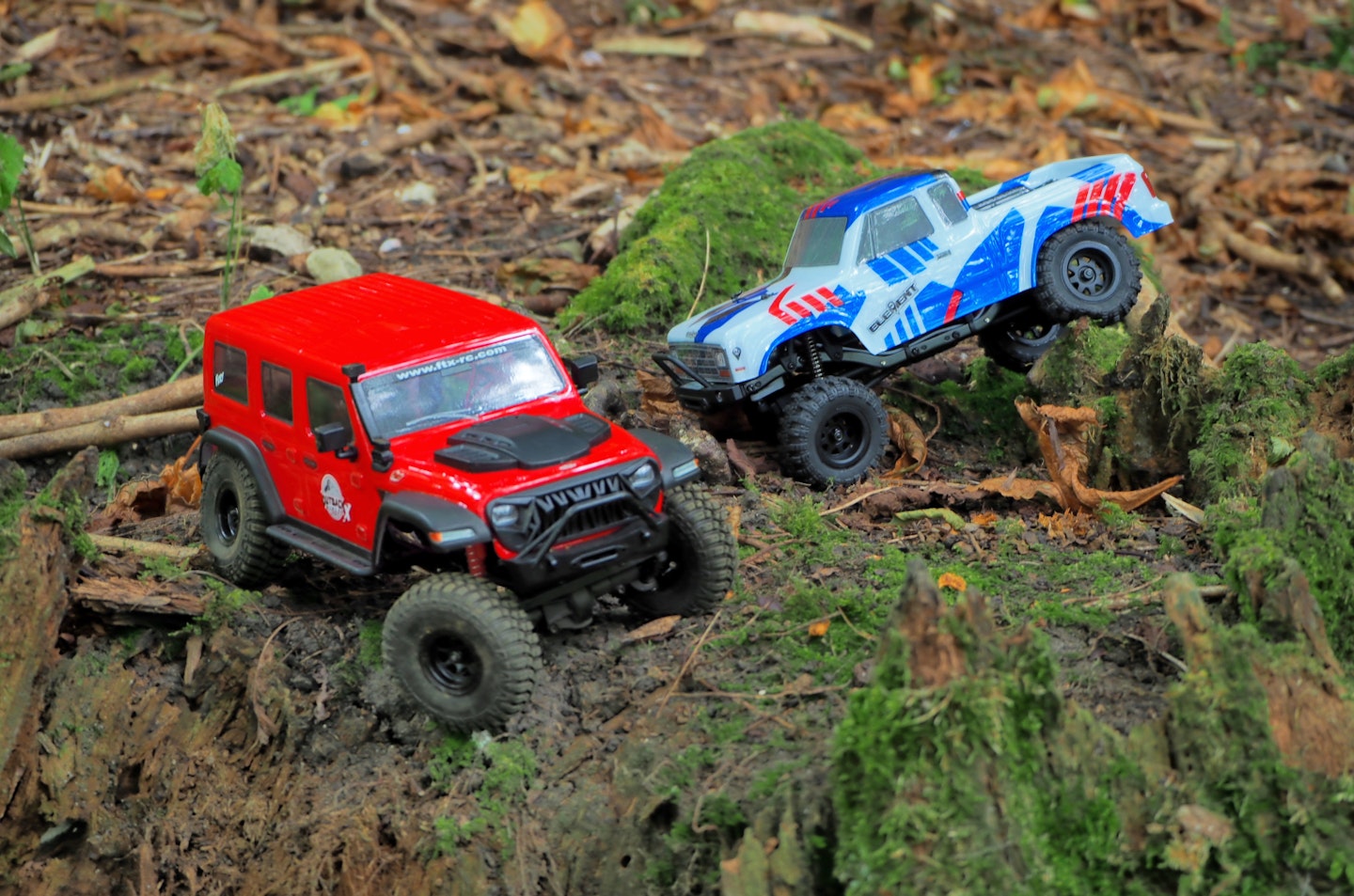
While we cannot reasonably compare the minis to the bigger trucks, at £100 a piece we do still expect a fair bit. The hill-climb speed test served the purpose to see if the wee machines were capable of scaling a slope, never mind how quickly. They could, so we threw them at Crawler Hill. It felt a little cruel sending the mini Fury and Enduro24 out there, like sending kittens to subdue an angry bull.
To their credit, they scuttled around alright. The mini Fury in particular bounced around over most things in its energetic way. The Enduro24 was more like a tortoise (without the mating sounds): slow but determined and surprisingly capable. I felt endeared to the little Enduro24 and was curious to see how it would get on when I would test it more thoroughly on its own.
Both of these runts still have proper four-wheel drive and multi-link suspension, hence their surprising ability. Away from the bigger 1:10-scale trucks, they are impressive in their own right, but in the larger company, it was admittedly difficult to remain focused on them.
Practicalities
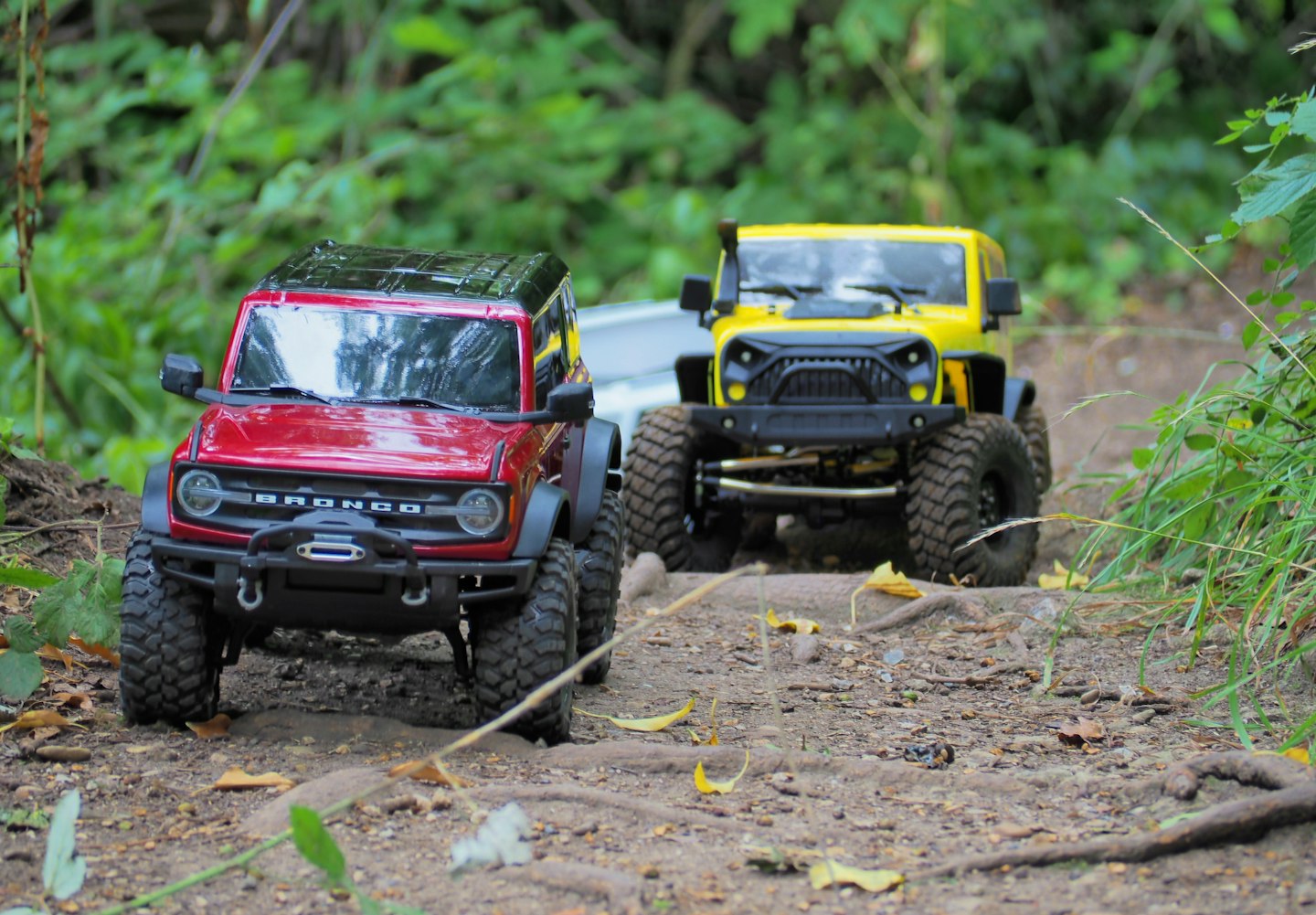
In the closing stages of our run, the Traxxas made a sterling final push up the valley and emerged exultant and triumphant. The Enduro tried again too and did succeed with a little bump from behind. But it’s crucial to know that straight out of the box, neither would have. Both the Traxxas and Enduro need batteries and chargers bought separately; until then they serve as merely an ornament. All the others do come with batteries and chargers supplied.
Though not tested here, all of the vehicles do have the ability to deal with moist particles to some degree. In the case of the minis and the Ravine, it’s splash proofing; in the case of the rest, it’s fully waterproof electronics, which allow puddle wading and brown water paddling if you wish.
Verdict
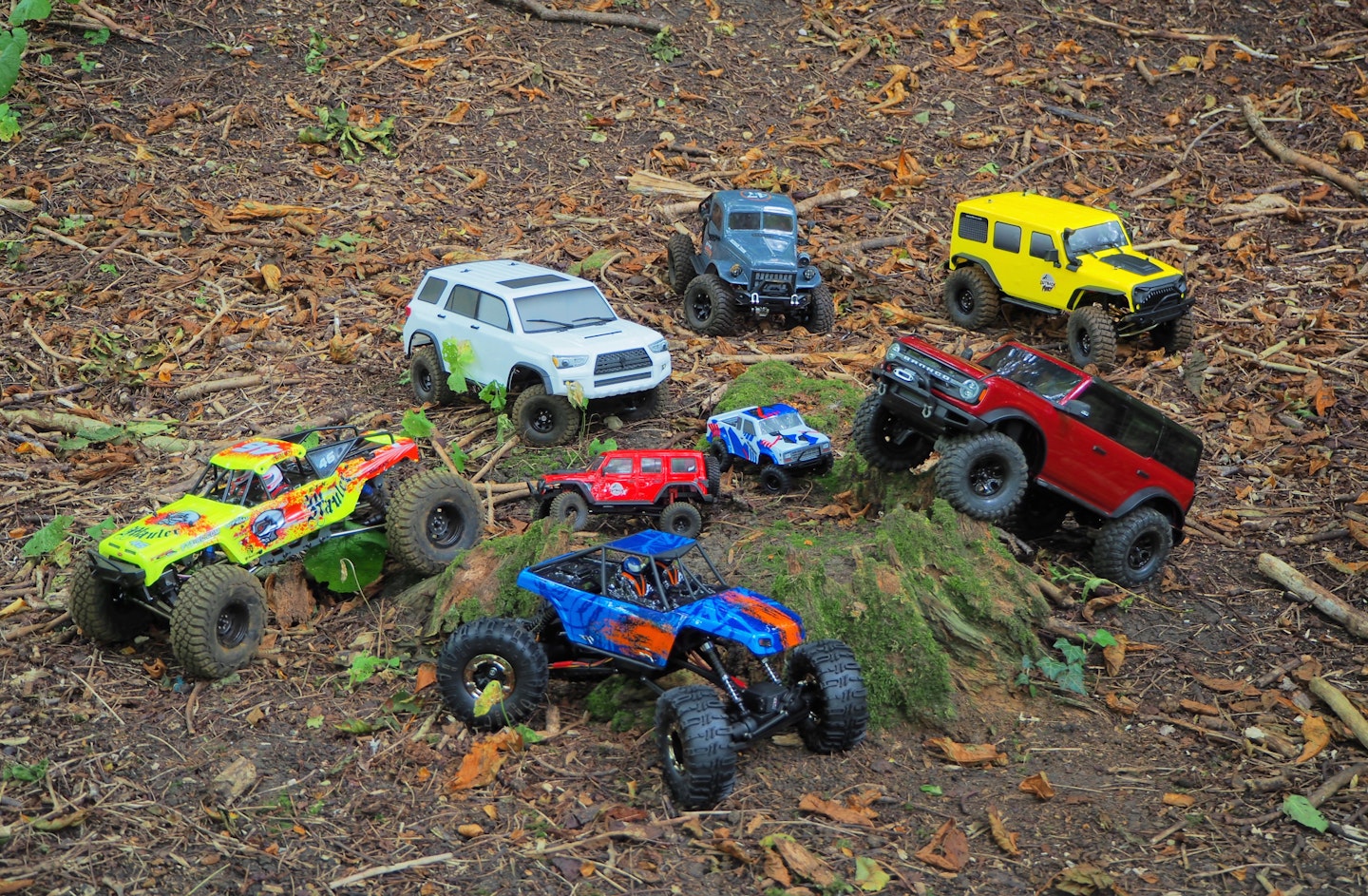
There was considerable discussion about this. It's not so much about what is best but what is best for certain people.
If your wallet is crying out to be emptied like a bladder in the morning, then go for the Traxxas Bronco. Not only is it the ablest off-roader of the lot, but it also looks as good as you would like it to. The Traxxas Bronco also has the advantageous trait over the full-size Bronco of being available in the UK.
But the Traxxas is very, very expensive. That is where the Element Enduro and Outback Texan come in. Both are very nearly as capable in standard, unmolested form as the Traxxas and for half the price. They, therefore, project an attractive beacon to RC rock crawler newcomers.
Thus, first place: Traxxas Bronco for people with money burning a hole in their pocket; or Enduro Element for those who don’t.
Second place: FTX Outback Texan because it looks brilliant and is almost as capable as the frontrunners.
Third place caused some debate. Opinions were divided. Adam proposed the Ravine; I championed the Mauler, and Ryan stood behind the Fury. While they both had valid reasons (the Ravine being fun and the Fury being fast), the benefit of writing the report is that I can flex some uncontested dictatorial powers, and obviously, my judgement is the correct one.
I like the Ravine but I feel its ability is limited to what we saw, whereas the Mauler, good though it is, can be made even better with some tuning. It’s also properly waterproof. And I think the Fury is a bit too unstable. It’s quick and blessed with fine steering and throttle control but it kept falling over.
The minis are quite a lot of money for what they are. Sure, they have some impressive hardware for such little machines but having seen the gaping chasm of ability difference between the minis and the 1:10’s, we were all in agreement it’s worth saving up for a bit longer to buy one of the bigger trucks.
Customising your RC rock crawler
If you get into your RC rock crawling, there is room for upgrades and customising. But before you buy the new motor, suspension, wheels, or whatever it is you have in mind, do your research first and perhaps talk to fellow enthusiasts. There are plenty of UK clubs to join.
In terms of run time, battery capacity counts for a lot but it's not the whole story. How much current the rock crawler draws also impacts how quickly you chew through that battery. We found the Traxxas' 5000mAh battery gave about two hours. The smaller 2000mAh battery in the FTX Mauler gave about 40 minutes of running. If you're making a day of rock crawling, we suggest getting a second or larger battery pack. Below are a couple of good options but you need to check the connector type and battery compatibility (including dimensions) of your specific vehicle first.
Read our full guide to RC car batteries to learn more, but below are a few recommended batteries.
Type NiMH | Connector type deans | Capacity 2400mAh | Voltage 7.2V | Cells 2 | Dimensions 135 x 45 x 25mm
Type LiPo | Connector type deans | Capacity 4000mAh | Voltage 7.4V | Cells 2 | Continuous discharge 50C | Burst discharge 100C | Dimensions 138 x 46 x 25mm
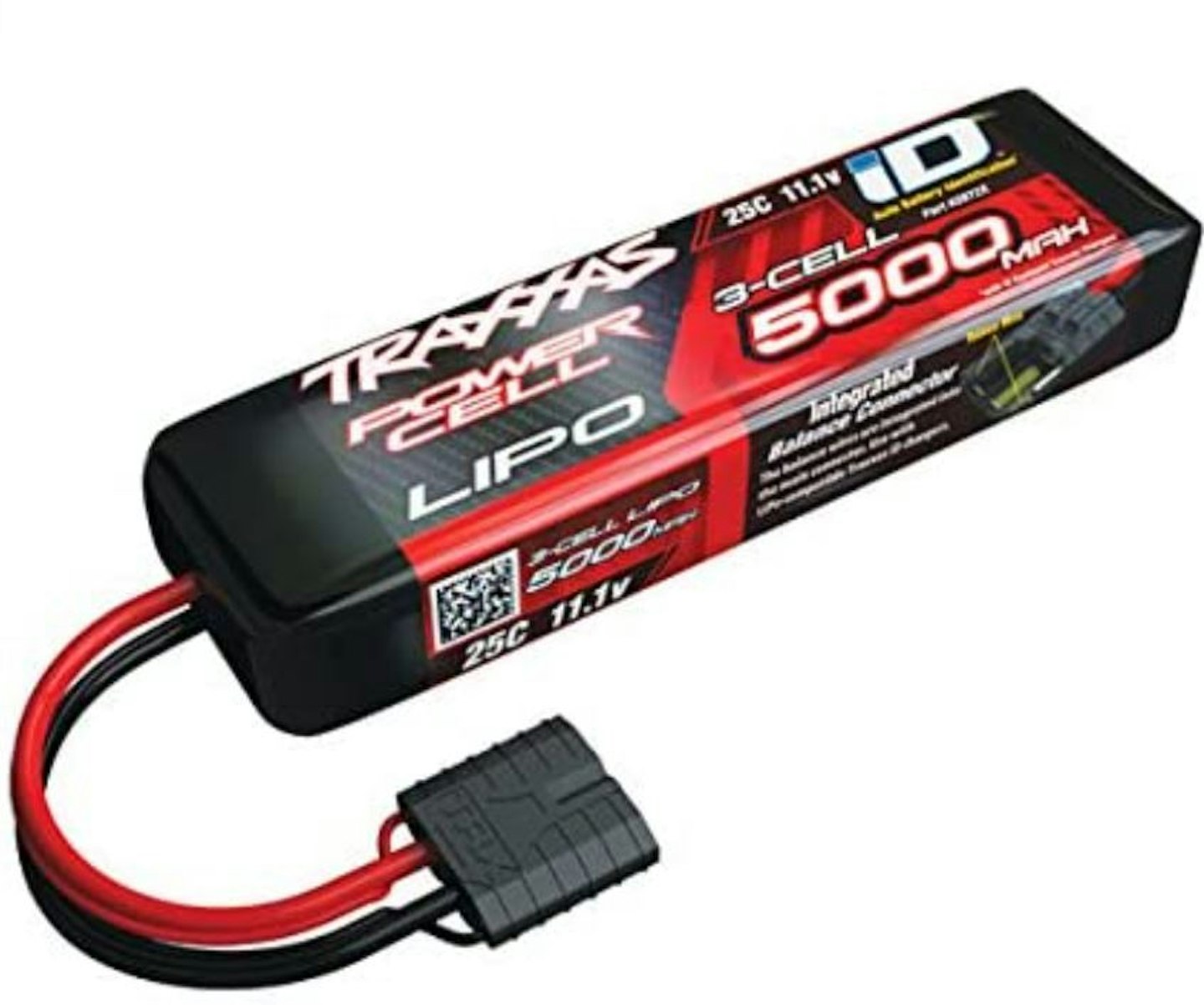
Type LiPo | Connector type Traxxas iD | Capacity 5000mAh | Voltage 11.1V | Cells 3 | Continuous discharge 25C | Burst discharge 50C | Dimensions 135 x 44 x 29mm
Caring for you RC rock crawler
While the motors, controllers, battery packs and other electronic parts may be waterproofed or kept in waterproof housings, that doesn't make RC rock crawlers submarines or idiot-proof.
If using your rock crawler in water, slush, mud, snow, or similar, you must set to removing dirt and moisture from the machine as soon as you've finished driving it. Check the motor is free of dirt and water and is completely dry (use cleaning spray if you need it).
Competing with your RC rock crawler
Groups of enthusiasts exist all over the UK. If you want to see how your machine gets on in a set course against others, jump onto Facebook and see what groups are local to you. They hold regular events and also provide a perfect opportunity to learn more about your machine. Alternatively, head to the BRCA page about RC rock crawling.
